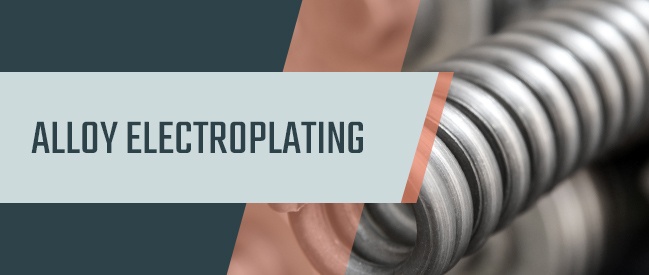
Electroplating is a popular and efficient method of strengthening metals. It's a necessity in so many industries, and its specific uses provide distinct advantages for each alloy type and application. It's also a complicated process that involves precise chemistry and attention.
While you could attempt it on your own, there is no guarantee you could garner the correct results. It's better left to professionals who are knowledgeable about the procedures and have experience conducting them. When you hire an electroplating company, you should still know the fundamentals of alloy application. This guide will help you understand how the alloy electroplating process works and why you should use it.
Quick Links
Alloys You Can Plate With | Benefits of Plating With Alloys | Industries That Use Alloy Electroplating
The Process of Alloy Electroplating | Why Sharretts Plating Company?
Alloys You Can Plate With
An alloy is a combination of two or more metallic elements. By bringing multiple metals together, an alloy can provide some of the benefits of each element.
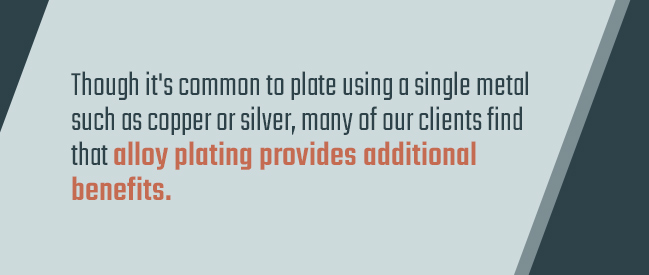
Though it's common to plate using a single metal such as copper or silver, many of our clients find that alloy plating provides additional benefits. The following are a few common alloys used in plating today:
- Zinc-nickel alloy: This alloy provides more corrosion resistance than a zinc coating alone. Adding a small amount of nickel to the mixture — usually between six and 20 percent — can help parts withstand corrosion when they're in contact with aluminum as well as endure greater temperatures compared to other zinc alloys. A zinc-nickel alloy plating can prevent the development of red rust up to 1,000 hours, making it a popular choice in the automotive industry.
- Palladium-nickel alloy: People often recommend palladium plating as a cheaper alternative to gold or platinum. However, a palladium coating alone is prone to cracking. Using palladium-nickel alloy instead can counter this problem. The electronics industry often uses palladium-nickel plating due to its low surface-contact resistance, though other applications exist as well.
- Tin-zinc alloy: Seeking a safer replacement for toxic cadmium coatings, many industries have turned to tin-zinc plating, which has similar beneficial properties. Tin-zinc plating provides protection against corrosion and prevents the appearance of red rust longer than cadmium coatings.
- Palladium-cobalt: Like palladium-nickel, palladium-cobalt alloy serves as a cost-effective alternative to gold in the electronics industry. This comparatively new alloy helps prevent deposit stress risk and cracking and may gradually replace palladium-nickel as the alloy of choice in some manufacturing processes.
All of these alloys provide unique advantages when they're used as coatings. The alloy that's right for you will depend on factors including budget, desired properties and purpose of the product.
Benefits of Plating With Alloys
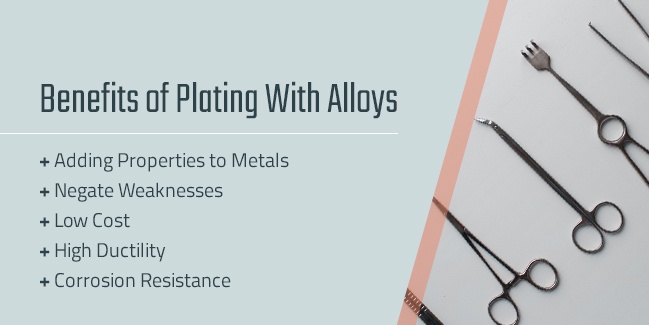
Plating surfaces with an alloy coating has many benefits. Not only does it give metals a lustrous look, but it also provides practical improvements. The advantages you'll see with alloy electroplating include:
- Adding properties to metals: Electroplating with alloys can add strengths that one metal may not be able to provide alone. Depending on the alloy and original metal you apply the plating onto, you can tailor specific properties for many different purposes. They can improve the functional performance of the metal and replace the use of environmentally harmful materials, such as lead and chromium. The particular functionality that electrodeposited alloys have depends on two factors — chemical composition and structure.
- Negate weaknesses: Additional layers can strengthen the original substrate, as seen in palladium versus palladium-nickel.
- Low cost: In addition to their physical properties, alloys may also appeal to manufacturers because of their low price. They can provide cost-effective alternatives to more expensive metals, like gold and platinum. Alloys are far less costly and more readily available than precious metals.
- High ductility: Alloys can improve the conductivity in electronic devices, including anything from power generators to computers. Some palladium alloys make perfect substitutes for gold in electronic devices while also reducing the overall weight.
- Corrosion resistance: Certain alloys — such as zinc-nickel — when applied onto surfaces prevent the substrate from corroding. This can be very helpful in the aerospace and automotive industries, where corrosion can quickly become an extreme safety hazard. Plating preserves the integrity of tools, vehicles and surfaces in all weather conditions.
With a wide array of advantages to offer, alloy electroplating is prevalent in many large industries. From safety concerns to cost efficiency to aesthetic preferences, there are many reasons why manufacturers include plating in their processes.
Industries That Use Alloy Electroplating
You may be surprised to find out how many industries and professions use alloy electroplating for its beneficial properties. From tiny, conductive elements to large, external components, alloys have a wide variety of uses and advantages. Let's take a closer look at how they are deployed.
1. Automotive
The automotive industry is a worldwide network of manufacturers. Every auto company looks for ways to make its offerings better than all the others in some way. One of the methods manufacturers have used to pull ahead is applying alloy electroplating to prevent or delay the onset of corrosion.
Rust is a menace in the automotive industry and a costly one at that. Reportedly, consumers collectively face about $23.4 billion worth of rust damages per year, with the majority accumulating in vehicle depreciation. Once corrosion sets in, it spreads quickly, especially on the body. It can eat through protective finishes and paints. If you see it on the surface levels, there's a good chance it's on underlying components as well, making the car more susceptible to an early death.
Alloy electroplating protects vehicles and their crucial parts from sustaining rust damage. Applying a thin layer of zinc-nickel to metal elements keeps corrosion from reaching the surface, preventing the formation of rust and further consequences. It's commonly used on components you'd find under the hood of a car, such as power steering apparatus, chassis hardware, brake systems and more.
You can also apply alloy plating onto plastics, such as on bumper areas. The zinc also enhances how it looks, providing a radiant finish similar to the appearance of chrome.
2. Electronics
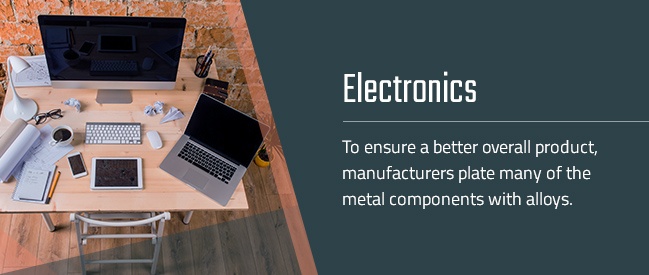
Finishing metal components in electronic devices with alloy plating is a delicate and challenging process. Experts need to have a mastery-level skillset to complete the job. Without the proper expertise, it's likely not even worth attempting. Luckily, the electronics industry has it covered.
Within all electronic products, including cellphones, computers, televisions and more, there are many different metal elements:
- Semiconductors, connectors, parts and components are all interconnected, creating functioning devices.
- With their products playing a significant role in everyday life for a majority of the world, electronics manufacturers have to process millions of metal parts on a day-to-day basis and create lasting, quality products.
To ensure a better overall product, manufacturers plate many of the metal components with alloys. It helps create electronics with longer lifespans, and it also makes the devices more resistant to potential corrosion and increases internal conductivity. For parts that need it, the alloy also increases the substrate's solderability, making it easier to configure with other components and elements. Alloys also protect delicate electronics from premature wear.
Palladium-nickel and palladium-cobalt are two popular alloys for plating in electronics. They're able to serve as an alternative to gold, which makes the end product far more cost-effective while also decreasing its weight.
3. Aerospace
Every component of an airplane is incredibly important. Regardless of the type of metal used in the manufacturing process, electroplating is necessary for finishing the aircraft's surfaces. Manufacturers have to ensure the individual pieces and finished craft are of the highest quality throughout production. The consequences of having a failure in the air are catastrophic, so reliability is essential.
There are also highly regulated quality-management guidelines to follow. SAE International introduced the AS9100 system in 1999, which encompasses all aerospace manufacturers worldwide and provides mandatory standards. Electroplating is necessary for meeting those criteria.
The modern industry relies mostly on titanium and alloys, as they combine the benefits of lightweight, low-density and high strength metals. However, titanium oxidizes quickly, which makes it difficult to bond with other metals. Metal finishing companies have developed a method for successful alloying with titanium, but the majority of aerospace companies don't have the expertise or ability to do it in-house.
Electroplating takes care of the primary concern in aerospace manufacturing — atmospheric corrosion. In the extreme conditions presented by flight, it can penetrate titanium, aluminum, steel and magnesium. Plating not only prevents corrosion, but it also extends the lifespan of aircraft and aids in refurbishing aging components.
4. Rail and Transportation

Railroads are no longer the titans of transportation they used to be. They are still highly significant in America and show no signs of losing their importance anytime soon. Considering their ages, railways and trains need to evolve and improve continually. The innovation of electroplating rail components goes as far back as pre-1913, which is why they've been able to survive so long.
As the processes have improved and become more refined, electroplating is still applied to trains and rails to keep them running. It helps the metal components last longer, even as they continue running in every type of weather and climate. The coating prevents natural corrosion and promotes safety in operation and construction. Some of the parts that require electroplating include:
- Track fasteners and clamps
- Electrical connections in vehicles and controls
Applying the coating is far more cost-effective than replacing the more expensive metals used in manufacturing rails and trains. Even saving a small amount at first makes a significant difference over time.
5. Others
While the above four categories already cover a broad spectrum of industries, they aren't the only ones that have standardized electroplating in their manufacturing and operational processes. There are plenty of other professions that need electroplated metals for their day-to-day operations, including:
- Defense: The military uses electroplating for tools like screws, gun barrels, shields, missile elements, communications systems, aircraft, radar and more. All of its equipment has to comply with military requirements and safety standards, and electroplating aids it in getting there. It also helps equipment last longer in all weather and terrain.
- Medical: When industries make equipment for surgeries and other medical uses, they have to ensure every metal element is biocompatible with the human body. Whether it's surgical tools or implants like plates and pacemakers, the right plating keeps patients safe from rejection or reaction. Proper compatibility and durability also mean less-frequent replacements for patients, and plating on scopes and similar tools can make procedures minimally invasive.
- Oil and gas: In drilling, there are plenty of apparatus that experience extreme conditions and harsh environments. The list includes extraction tools, such as pumps, drills, separators and shakers. Electroplating protects them through extended periods of heavy use and protects the integrity of the products they're extracting.
- Power generation: Modern power generation has expanded to solar panels, wind turbines and nuclear plants. The equipment is continuously exposed to the elements and running for long hours, so it needs reinforcement. Plating keeps it in peak performance and extends its lifespan, as well as improving conductivity.
Even with these additions, there are still more industries that use electroplating to their advantages. These examples show some of the most extensive and large-scale projects that require electroplating, where it's a necessity rather than an aesthetic preference. Regardless of the reason, the processes for electroplating are all relatively similar.
The Process of Alloy Electroplating
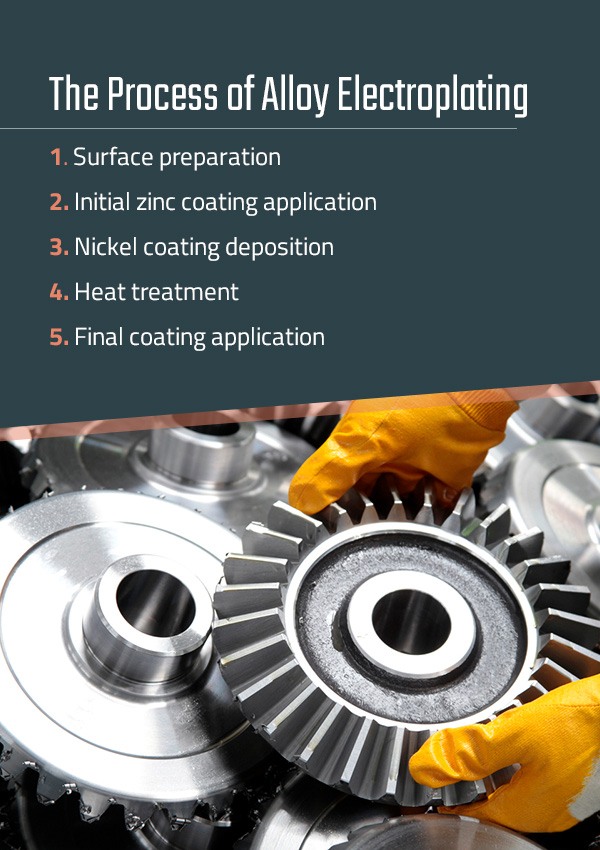
Depending on the metals you are electroplating onto alloys, the steps will change slightly, but the general process is the same. Metals go through a series of charged baths to transfer thin layers of elements onto the substrate, and then the plating is cured. Here's a more specific breakdown using a zinc-nickel alloy plating process:
- Surface preparation: One essential step in electroplating is preparation. If the surface you're plating isn't free from porosity and all friable material, the electroplated layer may not adhere to the metal. The bond should be as secure as possible. Cleaning the material involves dipping it into a strong alkaline solution or variety of acid, then rinsing it under running water.
- Initial zinc coating application: Next comes the first thin layer of zinc. You'll need to immerse the substrate in a zincating solution, rinse it under running water, return it to the acid briefly, rinse again and repeat that full cycle over.
- Nickel coating deposition: Similar to the zinc coating, the nickel process includes a series of baths. You immerse the treated substrate in a nickel solution for the required amount of time, rinse with running water, rinse again in de-ionized water and dry the substrate off.
- Heat treatment: Once the metal is finished with the baths, it needs heat treatment in an oxygen-free atmosphere. For a nickel-zinc alloy, the heat should be at about 200 degrees Celsius, and it should sit for approximately two hours.
- Final coating application: The final coating is electroplated onto the material using cathodes, copper wire and standard procedure.
The specifics may change for different alloys and processes can be scaled to fit the size of any piece of equipment. Electroplating is a complicated process, so it requires a skilled professional to carry out the whole procedure. If any step is incorrect, you could end up with plating that rubs right off or no plating at all.
Why Sharretts Plating Company?
When you're choosing a plating company, it's important for you to find professionals who know the intricacies of plating in your industry and who understand the importance of a metal finishing that performs. With more than 90 years of experience, SPC has the metal finishing expertise necessary to lead clients through the plating process. Our team of chemical engineers, scientists and industry professionals will work with you to develop a customized process that meets the needs of your product and industry.
SPC can handle the plating process from beginning to end, from helping you choose an appropriate metal or alloy to product preparation to finishing. If you're interested in learning more about our capabilities, contact us for a free quote.
Additional Resources:
Contact Us TO LEARN MORE ABOUT OUR MAGNESIUM PLATING SERVICES
Contact SPC today to receive your no-obligation plating quote or to learn more about how our many valuable magnesium plating services can help you maximize your manufacturing processes.
LEARN WHAT OUR MANY SATISFIED CUSTOMERS HAVE TO SAY ABOUT Us
"I would like to thank you for the help you have provided us in developing an electroless nickel plating technique on an unusual substrate. The sample platings you provided show that we should be able to reach our goals. I especially appreciate your willingness to take on an unusual job, with the uncertainties that that entails...We are looking forward to working with you in the future on our plating needs."
– Robert K.



